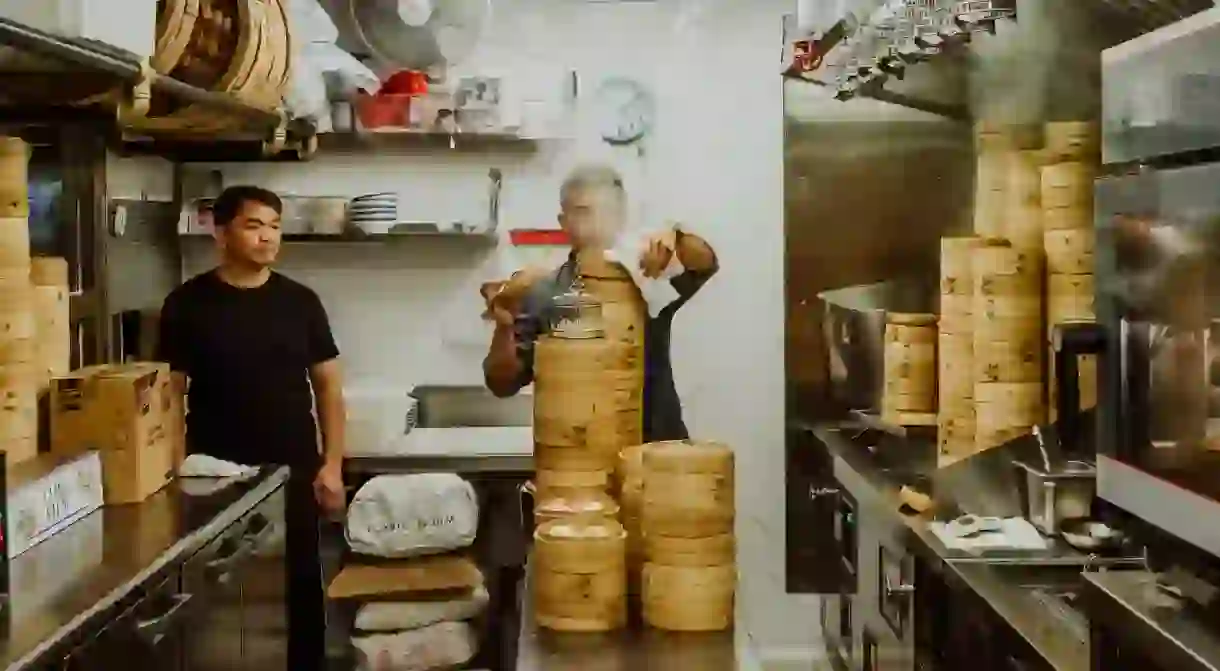Hungerlust: One Man Is Reshaping Yum Cha in Hong Kong

In Hong Kong, it’s a ritual for friends and families to gather for yum cha (the act of sipping tea and munching on dim sum). While there are many restaurants preserving and upholding traditional yum cha in Hong Kong, chef Winson Yip is transforming the experience by introducing flashy, Instagram-worthy dumplings.

In Hong Kong, yum cha is an opportunity to pluck bamboo baskets teeming with wobbly soup dumplings off roving carts and nurse mugs of tea with friends and family.

“When we have lunch gatherings … the culture is that we go out as a group for yum cha and conversation,” Winson Yip, chef at Yum Cha, a Hong Kong restaurant, explains.
But in Yum Cha’s kitchen, Yip transforms traditional yum cha into a spectacle, sculpting dim sum into playful shapes such as tail-wagging dogs and neon-coloured roses. He pays homage to classic dim sum dishes while simultaneously reinvigorating the centuries-old tradition by introducing character dim sum and social-media-friendly dishes to the masses.

What is yum cha?
For the uninitiated, yum cha may seem synonymous with dim sum, but the two terms are actually not interchangeable. Yum cha (which literally translates as ‘drink tea’) is the act of going to eat dim sum, gathering with friends and family and, of course, sipping tea.

“The meaning of yum cha is that when we eat dim sum, we sip tea,” says Yip. “The reason for that is there is oil or fat in the food we eat. It feels rich or heavy, so we sip hot tea to get rid of the greasy feeling in our mouths. That way we can eat more.”
What is dim sum?
Dim sum, on the other hand, is the general term for the inherently shareable small dishes – often compared to tapas – eaten during yum cha. The Cantonese were crafting dim sum long before there was dim sum in Hong Kong. The practice originated in Guangzhou centuries ago, but it has largely remained the same.

Dim sum always consists of fully cooked, bite-size dishes, served in steamer baskets or on small plates, to be shared with a group of people. In restaurants, it’s common for platters of dim sum to be wheeled out from the kitchen on trolleys, allowing diners to choose from a host of small dishes as they’re carted over. Baskets often brim with traditional dim sum like cha siu bao (roasted pork steamed buns), lo bart gao (slabs of fried turnip cake), crispy chicken feet glazed with sticky sauce and har gow (plump shrimp dumplings). Dim sum desserts include bright-yellow egg-custard tarts and silky tofu pudding.
Where to find character dim sum in Hong Kong
Although a host of those traditional dim sum dishes can be found at Yum Cha, Yip revels in transforming the old-world Hong Kong dim sum into modernised, newfangled creations.
“My view on traditional dim sum … is that I love it,” Yip says. “Because its taste and flavour is something recognised and remembered by Hong Kong people. We add new things to bring cheer and surprise to the diners.”

At Yum Cha, plates teeming with cute dim sum – edible pieces of art – grace tables. Instead of simply stuffing roasted pork into dough, Yip moulds buns to resemble pigs: he dots two black eyes and plasters pink ears and a snout onto pillowy buns. The pleated skin of vegetable and shrimp dumplings is stained in streaks of orange, green and purple. Pastry dough enrobing pineapple is shaped like tiny birds, presented to the table in a miniature birdcage.

As dishes like these might suggest, social media has proved to be incredibly advantageous not only for the restaurant but also for the dim sum tradition. “[Facebook and Instagram] help to show our dim sum culture to the world,” Yip says. “They show people what new-age dim sum is like.” Instagram in particular allows diners to share images of the Like-worthy creations; the restaurant’s location feed fills with image after image of colourful rose-shaped dumplings, cotton-candy clouds crowning red-bean puddings and videos of diners spearing squishy, googly-eye-studded buns with a chopstick, letting custard ooze out of the buns’ newly created mouths.

Even though Yip has a mission to revolutionise dim sum, he is adamant about maintaining tradition.
“When I went to a yum cha restaurant as a child, one thing I enjoyed was seeing dim sum trolleys around the place. The waitresses would announce, ‘Prawn ravioli, shumai, dumplings!’ There was that personal touch which made me feel warm and cosy,” he says. “Those memories stay with you forever.”

While there may not be trolleys floating around Yum Cha, Yip is certain guests will experience that personalised touch and warm feeling, whether it’s from biting into beautifully crafted pork dumplings or simply sharing a pot of tea with friends and family – the yum cha way.

Explore some of the world’s most vibrant cities through local chefs and unique food with the full series of Hungerlust.













